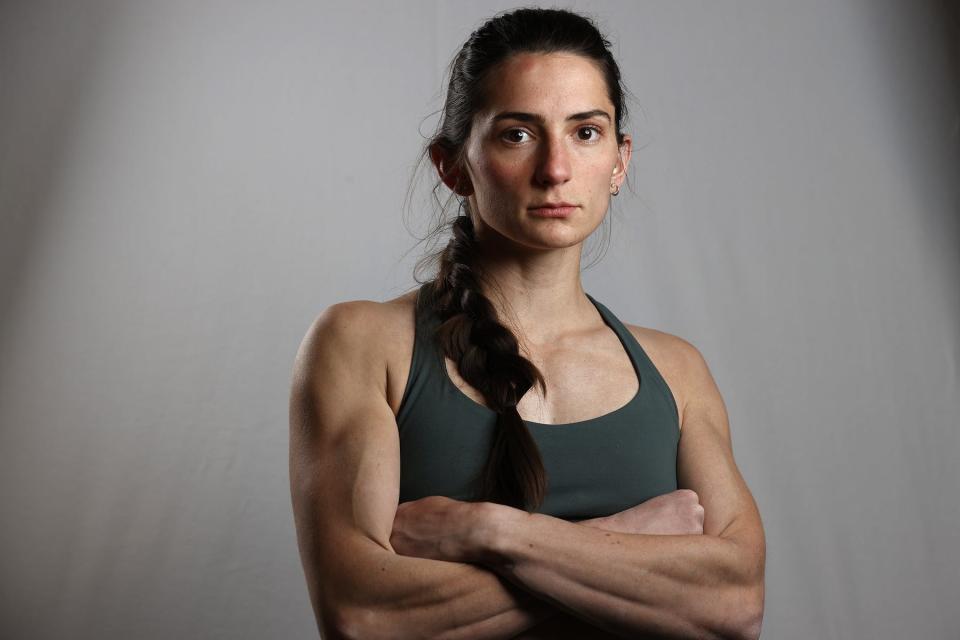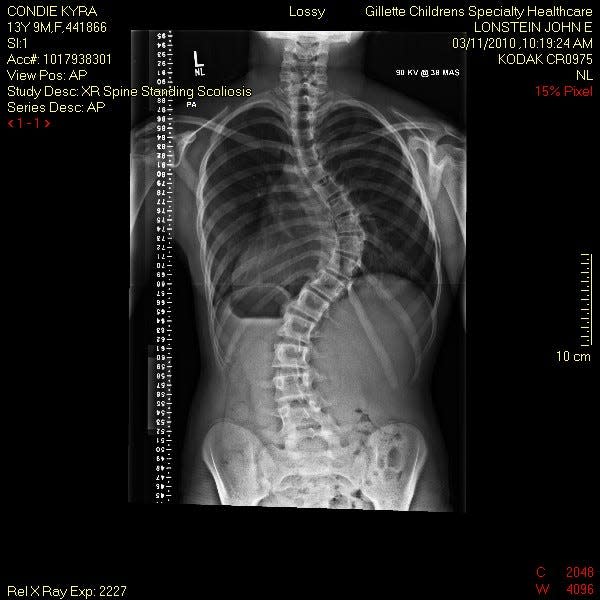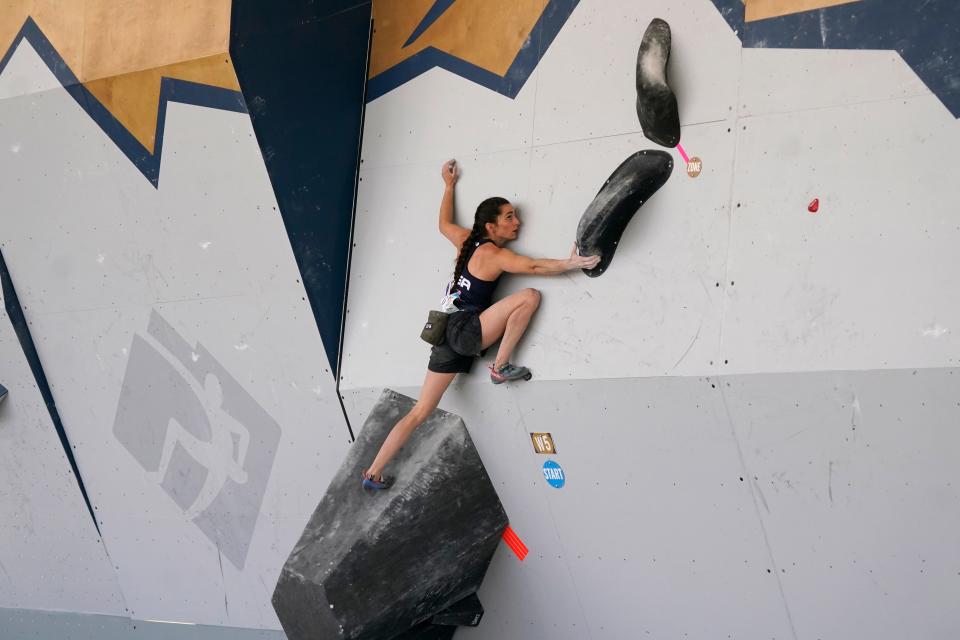US Olympic sport climber Kyra Condie not slowed after 10 fused vertebrae in her spine
- Oops!Something went wrong.Please try again later.
SALT LAKE CITY — Kyra Condie first noticed the pain in her back more than a decade ago, when she started rock climbing competitively. It wasn't a searing pain. More of a constant ache. But she said it left her feeling "like an old lady" – a worrisome sign, given that she was just 11 years old.
Condie didn't tell her parents about the pain, at least not right away. She's not the type to complain. But as the soreness lingered, she relented. And X-rays soon revealed a significant issue, especially for an aspiring young rock climber: Condie had a relatively severe case of scoliosis, a 52-degree curvature in her spine. She needed back surgery.
"It was way worse than I expected," Condie said.
Condie never doubted that she would return to climbing, but she wasn't sure how long she would be out, or whether she would ever be able to compete at the highest levels of her sport.
And she certainly didn't think she would ever be competing at the Tokyo Olympics.
WELCOME TO SPORT CLIMB: A visual guide to new event at Tokyo Games
But now, roughly 11½ years later, competitive rock climbing – or "sport climbing," as it is officially called – is making its Olympic debut in Tokyo. And Condie, with 10 fused vertebrae in her spine, will be there. She's one of just 20 women – including two Americans – to qualify for the Games.
"I’m a pretty tenacious person, so it was just something that I would have to deal with," Condie said of the 2010 back surgery, which sidelined her for four months.
"I think not letting myself get discouraged about it was a big part of it. Just dealing with it as it came."

Though it's been more than a decade since the procedure, the now 25-year-old Condie is still feeling some of its effects. She said she still has "general achiness" in her back. She uses a heating pad on a nightly basis. And because the upper part of her spine is essentially one solid mass, for example, Condie is unable to bend, twist or arch her back to reach certain spots on the wall, like some of her competitors.
But it hasn't hindered her rise in the sport.
"It’s a part of who she is now. She just works around it," her mother Cathy said. "It’s not something that defines her, I guess."
The X-ray
Condie's path to the Olympics began at a friend's birthday party at a Minnesota climbing gym, when the person who was belaying Condie told her that the gym had a youth climbing team.
For a child who grew up scaling neighborhood trees – and, in one instance, her parents' refrigerator – it was a natural fit.
"I was always climbing everything anyway," she said.
Before too long, Condie had graduated from the gym's regular youth climbing team to the advanced team. She had competed nationally, and had dreams of making it to the junior world championships, when her back pain became unmanageable.
The first X-ray of her spine revealed a dramatic S-shaped curve, leaving both Condie and her parents in shock. Cathy Condie asked doctors if her daughter really needed surgery. They told her that the curve would only worsen over time, and could potentially damage her lungs if left untreated.
"I rarely cry, but I did when I saw that, when I saw her X-ray," Condie's mother said. "That was tough."

The family sought out opinions from three different spine surgeons before scheduling the procedure.
Condie said the first one told her she wouldn't be able to return to climbing for at least nine months, if at all, then tried to console her by telling her that climbing wasn't all that important in the grand scheme of things. The second said she would be out for just four months, and asked that she send him a picture when she was on top of the podium.
Needless to say, Condie went with the second surgeon.
"He instilled a lot of confidence in me," she said. "He really believed that I was going to be able to climb again, which I think really helped."
The surgery
By the time Condie was on the operating table at Gillette Children's Specialty Healthcare in St. Paul, Minnesota, the curve in her spine had progressed to more than 70 degrees.
It was March 2010, a few months before her 14th birthday. In a procedure that lasted several hours, spine surgeon John Lonstein fused 10 vertebrae that run from the base of Condie's neck to the bottom of her rib cage – using a combination of rods, hooks and wires to straighten her spine.
She spent the next four days in the hospital – sometimes in severe pain, according to her mom.
"Basically, they break your back and put it back together," Cathy Condie explained. "Just lots of nerve pain and healing and spasms, muscle spasms."
Lonstein, who is now retired, said in an interview that he was confident Condie could return to climbing, based on the specific type of fusion procedure that she had. And Condie, buoyed by the surgeon's confidence, made sure she dilligently followed every recommendation during the rehab process.

Cathy Condie said that, as soon as her daughter could walk, she was walking at least a half mile a day, per Lonstein's instructions. She also started swimming, to improve her mobility without putting additional stress on her back.
Four months later, as promised, she was back in the gym.
"It just shows that even if somebody has scoliosis and they have a fusion, they can achieve things and do what they want to do," Lonstein said.
About 18 months after that, in early 2012, Condie won youth bouldering nationals for the first time.
She snapped a picture, sealed it in an envelope and sent it to Lonstein.
The recovery
Condie's back surgery is often framed as an obstacle that she's overcome. And, in fairness, it is. But it's also helped fuel her rise through the climbing ranks.
"I was kind of at that stage of life where I had been competing in a high-level sport at a young age, to where I was kind of burning out," Condie explained. "So to have climbing taken away from me at that point, with the back surgery, it made me really realize how much it meant to me. I then never lost any (excitement) after that."
The surgery has also shaped her climbing style. While Condie has always preferred the strong, straightforward approach to the "twisty, delicate, technical" style of climbing, the back surgery pushed her even further in that direction. In situations where most climbers might finesse their way to a hold, she has to compensate with strength.

It's all worked out well so far. Condie won gold at the 2018 Pan American Championships, then placed seventh in a 2019 Olympic qualifying event to secure her trip to Tokyo.
The sport climbing competition begins Aug. 3 at Aomi Urban Sports Park in Tokyo.
It might seem dangerous, the idea of rock climbing competitively after undergoing a serious back surgery. But Lonstein said Condie isn't more at risk of sustaining an injury while climbing than anyone else.
While she's discouraged from activities like skiing or collision sports, where there is a significant risk of sustaining a blow to the head, climbing is perfectly fine.
"I let people do it. And if they find that they are restricted by their fusion, they’ll stop," Lonstein said. "People like Kyra – she just doesn’t let anything stop her."
Contact Tom Schad at tschad@usatoday.com or on Twitter @Tom_Schad.
This article originally appeared on USA TODAY: Olympics: Sport climber Kyra Condie not slowed by spinal fusion surgery

